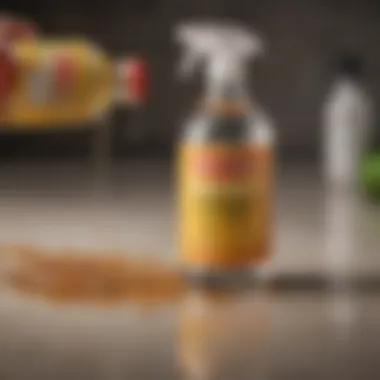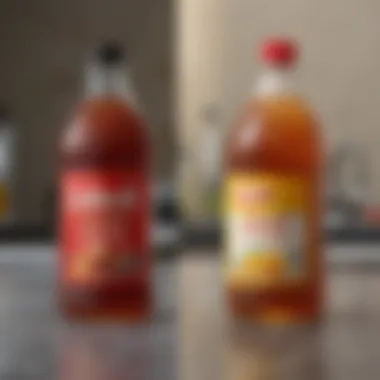Create Your Own Vinegar Cleaner: Step-by-Step Guide


Intro
Crafting your own cleaner from vinegar is not just a trend; it’s a practical approach that can save money while being gentler on the environment. Many folks are waking up to the power of natural cleaning solutions, and vinegar sits at the top of that list. With a few straightforward ingredients and a touch of care, you can make a simple yet effective household cleaner tailored to your needs.
In this guide, we’ll lead you through the entire process of creating your vinegar-based cleaner. We’ll discuss its components, effectiveness, and myriad applications, empowering you to take control of your cleaning routine. By the end, you’ll see why vinegar is such a superstar in the cleaning world, often favored over commercial options that can be laden with harsh chemicals.
Let’s roll up our sleeves and start exploring the nitty-gritty of crafting your very own vinegar cleaner, a sustainable choice for a spotless home.
Recipe Overview
Recipe Name
Vinegar All-Purpose Cleaner
Cuisine Type
Eco-Friendly Cleaning
Ingredients
List of Ingredients with Measurements
- 1 cup white vinegar
- 1 cup water
- Optional: 10-15 drops of essential oil (like lemon or tea tree for fragrance and extra cleaning power)
Substitutions for Common Ingredients
- If you can't stand the smell of vinegar, you can use apple cider vinegar, though it may leave a slight tint.
- For a different scent, consider lavender or eucalyptus essential oil instead of lemon.
- If you’re looking for a more potent cleaner, replace the water with witch hazel.
Creating your own vinegar cleaner not only reduces waste, but also gives you control over what goes into your home environment. Plus, it really works wonders!
Foreword to DIY Vinegar Cleaner
Creating your own vinegar cleaner may seem like just another household chore, but it opens up a world of benefits that go beyond mere cleanliness. The beauty of crafting a vinegar-based cleaner lies in its simplicity and effectiveness, not to mention the eco-friendly angle that appeals to a growing number of households today. This section aims to set the stage for why making your own vinegar cleaner is worth the time and effort.
The Rise of Eco-Friendly Cleaning Solutions
In recent years, there has been a noticeable shift towards more environmentally conscious cleaning solutions. People are becoming more aware of the harmful chemicals in commercial products, leading them to seek alternatives that don't compromise on results.
The push for eco-friendly cleaning is fueled by the desire to live healthier lives. After all, who wants to inhale something laden with synthetic ingredients and fragrances? Oftentimes, these products, while effective at cleaning, can leave behind residues or cause allergic reactions. This has many individuals and families turning to holistic options, one of which is vinegar cleaner.
Vinegar, an age-old remedy, has been harnessed for all sorts of uses—from cooking to cleaning and everything in between. Its natural acidity serves as a powerful ally against stains and odors. This choice helps in reducing chemical waste and ultimately fosters a more sustainable living environment.
Understanding Vinegar as a Cleaning Agent
Vinegar is not just for salad dressings; its prowess as a cleaning agent has been documented in various studies. The acetic acid in vinegar provides a multitude of benefits: it cuts through grime, eliminates odors, and acts as a mild disinfectant. This is not to say that vinegar is a magic potion; it has its limitations, but when used appropriately, it can yield fantastic results in any cleaning regimen.
Many people are surprised to learn that vinegar can effectively dissolve mineral deposits and is a great option for cleaning glass surfaces. Plus, the beauty of vinegar lies in its versatility. You can tailor it to your specific needs—whether it's a glass cleaner, deodorizer, or all-purpose cleaner, you can mix in optional additives to enhance its cleaning power even more.
"Vinegar is a key ingredient in countless households, often serving dual purposes, from marinades to minty-fresh cleaners."
In summary, adopting a DIY approach to vinegar cleaning not only nurtures a clean home but also contributes significantly to sustainable practices. As we delve further into crafting your own vinegar cleaner, we will uncover various components and methods to harness this most humble of ingredients to achieve a pristine and pollutant-free living space.
Components of a Vinegar Cleaner
Understanding the components that make up a vinegar cleaner is crucial for anyone interested in making their own cleaning solution. Knowing these components not only helps in crafting an effective cleaner but also provides insights into how each ingredient contributes to the overall cleaning process. The versatility of vinegar makes it a popular choice for those wary of commercial cleaners packed with harsh chemicals. Here, we’ll discuss the key elements that can enhance the effectiveness and appeal of your vinegar cleaner.
The Role of Vinegar
At the heart of your homemade cleaning solution lies vinegar, an ingredient that boasts a multitude of benefits. Vinegar, particularly white vinegar, is renowned for its acetic acid content, which is effective in breaking down grime, mold, and even mineral deposits that can accumulate over time. Just a splash of vinegar can breathe new life into your surfaces, making them sparkle without leaving behind toxic residues. This means that using vinegar is not only a smart cleaning choice but also a safer option for households with children or pets.
"The simplicity of vinegar as a cleaner lies in its ability to tackle stubborn dirt and eliminate odors naturally."
Vinegar's acidity ensures it can neutralize many unpleasant smells, adding another layer of utility to this ordinary kitchen staple. When mixed correctly, vinegar can be a powerhouse that rivals many store-bought cleaners while also being easy on the wallet.
Optional Additives for Enhanced Cleaning
While vinegar is a formidable cleaner on its own, combining it with certain additives can take its cleaning prowess to the next level. The following optional ingredients can infuse your vinegar cleaner with enhanced properties, making it even more effective.


Essential Oils
Essential oils can add both fragrance and additional cleaning properties to your vinegar cleaner. For example, tea tree oil is extremely popular due to its antimicrobial effects, making it a fantastic addition if you’re looking to supercharge your disinfectant. Lavender oil, on the other hand, not only imparts a soothing scent but also boasts antibacterial qualities. These oils can elevate your cleaning experience, turning a chore into a more enjoyable task.
The distinctive aroma of essential oils can help mask the sharp scent of vinegar, making your cleaner all the more pleasant to use. It's important to keep in mind, however, that some essential oils can react differently with surfaces or produce allergies in sensitive individuals, so it’s wise to test a small area first.
Baking Soda
Baking soda is another fantastic additive known for its abrasive properties and odor-neutralizing capabilities. When mixed with vinegar, it creates a fizzy reaction that can dislodge dirt and debris in a jiffy. It’s particularly useful for tackling tough stains and grime that might have settled in challenging spots like sinks or stovetops.
One unique feature of baking soda is its ability to absorb odors rather than just masking them. This makes it a real boon in environments where smells can linger, such as kitchens and bathrooms. However, it's crucial to use it in moderation, as overuse can lead to residue buildup, which might require additional cleaning to remove.
Hydrogen Peroxide
Using hydrogen peroxide in your vinegar cleaner adds an extra punch against bacteria and viruses. Known for its disinfectant properties, hydrogen peroxide can enhance the cleaning power of vinegar. Just like baking soda, it can create a bubbling reaction that helps lift grime. It’s especially handy when cleaning high-touch areas like doorknobs or kitchen counters, where germs tend to thrive.
One distinctive quality of hydrogen peroxide is its bleaching properties, which makes it effective for whitening surfaces like grout or white tiles. On the downside, exposure to light can degrade hydrogen peroxide, so it should be stored in a dark container to maintain its efficacy. Also, avoid mixing it with vinegar as the combination can produce harmful vapors.
Choosing the Right Vinegar Type
When it comes to crafting your own vinegar cleaner, not all vinegar is created equal. Each type brings its own strengths and best uses depending on your cleaning needs. Let's break down the different varieties:
White Vinegar
White vinegar is often considered the gold standard for DIY cleaners. Its high acetic acid content—around five percent—makes it extremely effective at cutting through grease and grime. Because it's devoid of any color, white vinegar won’t stain surfaces, making it an ideal choice for cleaning everything from windows to floors.
Furthermore, white vinegar is quite inexpensive and widely available, allowing you to stock up without burning a hole in your pocket. Just be cautious when using it on natural stone surfaces, as it can etch them over time.
Apple Cider Vinegar
Apple cider vinegar has a slightly milder acidity compared to white vinegar and also possesses a unique scent. While it works well as a cleaner, its uses extend beyond just household cleaning; people often utilize it for personal care, making it multi-purpose. This vinegar is particularly effective for deodorizing and can add a pleasant aroma to your cleaning routine. However, it’s essential to note that its color could pose a risk of staining if used on light-colored fabrics or surfaces.
Wine Vinegar
Wine vinegar, available in both red and white varieties, comes with similar cleaning properties but is less commonly used for this purpose. It can, however, serve as a charming addition to homemade salad dressings and certain culinary applications. The acidity level varies, so it's generally less effective for cleaning than white or apple cider vinegar. Your wine vinegar might be better suited for enhancing flavors in your kitchen rather than as a dedicated cleaner. Still, if you have some spare bottles at home, you can use them in a pinch for casual cleaning tasks.
Understanding these components will simplify the process of crafting your own vinegar cleaner. By leveraging the right combinations, you can create effective solutions tailored to your cleaning needs.
The Cleaning Process: Step-by-Step Instructions
The act of cleaning is often seen as a mundane chore, but when utilizing homemade solutions like a vinegar cleaner, it can transform into a more engaging and fruitful endeavor. The cleaning process encapsulates not only the physical act of wiping surfaces but also understanding how different ingredients synergize to create effective solutions. This section emphasizes why having a clear, step-by-step set of instructions can lead to better results and enhance the overall cleaning experience. Clear instructions help avoid the trap of trial and error, ensuring you create a solution that effectively tackles various cleaning tasks with ease.
Preparing Your Ingredients
Before diving into mixing, gathering the right ingredients is crucial. For effective cleaning, you need to ensure that everything is on hand to streamline the process. The ingredients for your vinegar cleaner are quite simple and usually found right in your kitchen. Typically, you’ll need vinegar (preferably white vinegar for its strong acidity), water, and any additional ingredients you choose for enhanced cleaning power. Here’s how to prepare:
- Gather white vinegar or apple cider vinegar.
- Distilled or filtered water is best to avoid mineral deposits in sprays.
- Choose optional additives like baking soda or essential oils set them aside.
Make sure your work area is tidy and ready for use. This will save time and prevent any mishaps while whipping up your cleaner.
Mixing Proportions for Different Applications
The beauty of using a vinegar cleaner lies in its versatility. You can customize the mixture depending on the specific cleaning task at hand. This section breaks down the key mixtures to ensure your efforts yield the desired cleaning effects.
General All-Purpose Cleaner
The all-purpose cleaner serves as the backbone of your cleaning routine. It’s a go-to solution for most surfaces, whether it be kitchen counters or bathroom sinks. Generally, the ratio for this cleaner is one part vinegar to one part water. This combination delivers just the right potency needed to cut through grime without being overpowering. A key characteristic of this cleaner is its neutrality, making it suitable for most surfaces. Its unique feature is that it’s non-toxic while remaining effective, which is one big reason why this mixture is so widely favored. The downside? It might not be as effective for deeply embedded stains, but it does a commendable job across the board.
Glass Cleaner
When it comes to cleaning glass surfaces, a specialized mixture is essential. For a vinegar-based glass cleaner, the proportions should lean more towards vinegar—try three parts vinegar to one part water. This high acidity targets tough spots and provides a streak-free shine. The beneficial aspect of this solution is the absence of harmful chemicals; it’s safe for pets and children. A unique feature is its quick evaporation rate, which helps reduce streaking on glass. However, be cautious; using this cleaner on mirrors might reveal imperfections in surface finishes if used too often.
Disinfectant Solution
To tackle bacteria and germs lurking in your home, a concentrated disinfectant is paramount. Mix one cup of vinegar with one cup of water along with a splash of hydrogen peroxide for enhanced disinfecting properties. This cleaner is particularly effective on non-porous surfaces, providing peace of mind in areas that need an extra touch of sanitation, like kitchen surfaces or bathrooms. The key characteristic here is its disinfecting power without toxic residues. The downside? It may not handle all types of mold or mildew, requiring a more targeted approach in those cases, but it’s a solid start for many cleaning tasks.
Storage Tips for Your Cleaner


Once you've crafted your cleaners, knowing how to store them is just as vital as creating them.
- Use glass spray bottles as they are friendlier towards acid-based solutions than plastic options.
- Label the bottles clearly so you don’t confuse them with other mixtures.
- If possible, store your cleaners in a cool, dark place to prolong their lifespan.
- Always keep them out of reach of children and pets for safety.
Mixing your own vinegar cleaner not only cuts down on expenses but also empowers you with knowledge about everyday cleaning. This preparatory stage sets a solid foundation for understanding how proper proportions can deliver exceptional results, helping you maintain a clean and healthy living space.
Effectiveness of Vinegar Cleaner
The effectiveness of vinegar cleaners cannot be overstated. In a world overloaded with industrially produced cleaning agents, people are seeking more natural, eco-friendly alternatives. Vinegar stands out not only for its cleaning prowess but also for being gentle on both the environment and human health. This section dives into how vinegar compares to commercial cleaners and identifies specific areas where its cleaning effectiveness truly shines.
Comparative Analysis with Commercial Cleaners
When it comes to cleaning, the market is flooded with commercial products that promise a spotless finish. However, many of these cleaners contain harsh chemicals that can be detrimental to our health and the planet. Vinegar, on the other hand, boasts acetic acid, which serves as a natural degreaser and disinfectant. The simplicity of vinegar lies in its ingredient list; it’s simply vinegar, water, and optional additives like essential oils for fragrance.
Despite its humble background, vinegar can hold its own! Studies show that vinegar can effectively kill bacteria, while certain commercial cleaners may be overkill for everyday cleaning tasks. For routine cleaning, using vinegar is a gentle yet capable alternative that cuts through dirt without introducing additional toxins into your living space.
Areas Where Vinegar Shines
Removing Odors
Odor removal is where vinegar truly showcases its full potential. The unique property of vinegar allows it to neutralize odors, rather than just masking them. Many people are familiar with the smell of vinegar itself, but what happens is that it bonds with the odor molecules, effectively removing them from the environment.
This makes vinegar a particularly popular choice for eliminating kitchen smells – be it from overcooked meals or leftover items in the fridge. When you use vinegar in an open bowl or dilute it and spray it around, it can eliminate those lingering scents that could otherwise spoil the atmosphere of your home. Unlike commercial air fresheners that often introduce more synthetic fragrances, vinegar tackles the issue on a molecular level, making it a highly effective, safe option.
Cutting Through Grease
Another area where vinegar stands tall is its ability to cut through stubborn grease. This characteristic makes it undeniably beneficial for kitchen use, especially for those greasy surfaces that often meet a plethora of food spills. While commercial degreasers often require multiple applications to yield results, vinegar can penetrate grease with much more ease.
Just mix equal parts of vinegar and water in a spray bottle and attack those greasy stovetops or grimy oven surfaces. The acetic acid in vinegar breaks down the grease so well that a simple wipe can bring back the shine. This method creates an efficient cleaning experience that doesn’t involve harsh chemicals that could irritate your skin or damages surfaces.
Disinfecting Surfaces
With the focus on hygiene heightened in recent times, the ability of vinegar to disinfect surfaces has captured attention. While vinegar isn't a registered disinfectant and won’t claim to kill all germs, it can effectively reduce microbial presence on surfaces. The acetic acid offers a mild antibacterial effect that can help you maintain a cleaner home.
For general disinfection, vinegar can be used on countertops, cutting boards, and bathroom surfaces. Simply apply undiluted vinegar, let it sit for a few minutes, and then wipe it clean. This process can pose as a more sustainable cleaning approach, as it keeps harmful substances away from your home while reinforcing a safer environment.
"Vinegar provides a cleaning solution that balances effectiveness with safety, making it a unique choice for conscientious consumers who don’t want to compromise on cleanliness or health."
In summary, vinegar’s effectiveness ranges across various cleaning tasks, presenting itself as a feasible contender against commercial cleaners. Its ability to remove odors, tackle grease, and disinfect surfaces solidifies its place as a staple in any eco-friendly cleaning routine.
Practical Applications in the Home
Understanding how to effectively use your homemade vinegar cleaner is the crux of making it a staple in your cleaning routine. Vinegar, with its acidic properties, shines in various applications around the house. Utilizing this eco-friendly solution not only benefits the environment but also saves you a pretty penny compared to commercial cleaners. Each area of your home presents unique challenges—kitchen spills, bathroom grime, and general household dust—making it crucial to adapt your vinegar cleaner for each situation.
Kitchen Cleaning
The kitchen is often the heart of the home, and keeping it clean is essential not just for aesthetics but also for safety. When it comes to kitchen cleaning, vinegar can tackle a variety of messes.
Here are some ways to employ your vinegar cleaner:
- Countertops & Surfaces: A quick spray of a vinegar solution can disinfect countertops and other surfaces, killing germs without the need for harsh chemicals. Just be cautious with porous materials like marble.
- Removing Stains: If you're dealing with stubborn grease or food stains on appliances, vinegar can break down those sticky messes. Just spray, let it sit for a few minutes, and wipe it down.
- Cleaning the Microwave: To banish odors and make the microwave shine, mix equal parts of water and vinegar in a microwave-safe bowl. Heat it for several minutes to create steam, then easily wipe down the interior.
Vinegar is not only effective; it’s also versatile. Whether removing odors from the trash can or cleansing fruit and vegetables, the applications are still plentiful.
Bathroom Maintenance
In bathrooms, cleanliness is next to freshness! The damp environment creates a breeding ground for mold and mildew, making it vital to keep spaces pristine.
Here are some key uses of vinegar in your bathroom cleaning regimen:
- Shower Doors and Tiles: Hard water stains become a thing of the past with a resolution of vinegar and water. Spraying this mixture onto affected surfaces removes grime and restores luster.
- Toilet Cleaning: Simply pouring vinegar into the toilet bowl can help break down mineral deposits. Let it sit for a while before scrubbing, and you’ll see a noticeable difference.
- Faucet and Sink Maintenance: Hard water stains on faucets can be annoying. Applying a dedicated vinegar solution will dissolve those unsightly deposits without causing damage.
Regular maintenance with vinegar can extend the lifespan of your bathroom fixtures while ensuring that everything sparkles and shines.
General Household Use
Beyond kitchens and bathrooms, vinegar can come to the rescue throughout the house.


Consider these applications:
- Laundry Boost: Adding vinegar to your laundry cycle can help remove odors and soften fabrics naturally.
- Odor Elimination: If pets are a part of your life, vinegar can help neutralize bad odors. Simply place a bowl of vinegar in the area, and let it work its magic.
- Window and Mirror Cleaner: A blend of vinegar and water makes for a remarkable glass cleaner. This combination leaves windows streak-free and shining bright.
Vinegar can be a jack-of-all-trades for cleaning applications, showing its multi-functionality throughout various areas of the home.
With vinegar as part of your cleaning arsenal, you not only enhance your cleaning efficiency but also advocate for a more sustainable lifestyle. Personalizing how you incorporate vinegar cleaner in different scenarios will keep your home fresh while sticking to eco-friendly principles.
Addressing Common Concerns
When it comes to creating your own vinegar cleaner, addressing common concerns is an essential part of the journey. Knowing what to watch out for not only enhances your cleaning experience but can also save you from potential mishaps. People may raise an eyebrow at using vinegar—a simple kitchen staple—as a cleaning solution. Thus, understanding the specific considerations surrounding this approach is key. Examining those aspects enhances confidence, ensuring that you can make informed decisions while maintaining a clean home.
Potential Risks and Safety Precautions
Avoiding Surfaces That React with Vinegar
When using vinegar for cleaning, it is crucial to avoid surfaces that may react negatively. Certain materials such as natural stone, granite, and marble can be sensitive to the acidity in vinegar, leading them to etch or dull over time. Understanding this specific aspect is vital because it can prevent damage to your beloved countertops or floors. This precautionary measure lends itself to the overall goal of crafting your cleaner while keeping your living space in top shape.
Recognizing how vinegar interacts with different surface types highlights its unique role in your cleaning routine. Being cautious about where you use it provides peace of mind. Vinegar can work wonders on many surfaces, yet it isn’t a one-size-fits-all solution. Thus, identifying delicate surfaces is a beneficial choice, ensuring that you're not inadvertently ruining your investments while trying to clean.
Proper Mixing Techniques
Another essential consideration is proper mixing techniques. Diluting vinegar with water, for example, is a straightforward method to adjust its strength for various cleaning tasks. This simple technique plays a crucial role in tailoring your mixture for specific needs—whether it's a glass cleaner or an all-purpose solution, the concentration of vinegar can make a world of difference.
This approach not only optimizes effectiveness but also minimizes the risk associated with using undiluted vinegar—especially in households with children or pets. By mixing correctly, you create a balanced solution that packs a punch without overwhelming surfaces. The unique feature of understanding proper mixing is that it allows you to unlock the full potential of your vinegar cleaner without the fuss.
Storage and Shelf Life of Vinegar Cleaners
Proper storage techniques for vinegar cleaners can extend their shelf life and effectiveness. While vinegar has a long shelf life on its own, once mixed with other ingredients, its properties can change. Ideally, store your mixture in cool, dark places and ensure the container is tightly sealed. Going for dark glass over plastic helps maintain its potency, as light can cause some degradation.
Additionally, it’s a good idea to label your containers with the date you mixed the solution. This way, you can keep track of its freshness and efficacy, ensuring that you always have a reliable tool close at hand.
In essence, understanding the risks, proper mixing, and storage of your vinegar cleaners can make a significant difference in how effective and safe your DIY cleaning experience will be. By keeping these aspects in mind, you're well on your way to becoming a confident vinegar cleaner aficionado with a cleaner, greener home.
Environmental Impact of DIY Cleaners
When it comes to maintaining a clean home, many of us often overlook a crucial aspect: the environmental consequences of the products we use. Here’s where DIY cleaners, particularly vinegar-based solutions, enter the picture. Understanding their environmental impact not only reveals how we can clean our spaces effectively but also allows us to contribute positively to the planet.
Benefits of Reducing Chemical Waste
Making your own vinegar cleaner is an excellent step toward minimizing chemical waste. Traditionally, commercial cleaning products are laden with a cocktail of harsh chemicals, which can eventually seep into our waterways, harming aquatic life and polluting our ecosystems. By opting for a DIY vinegar cleaner, individuals can cut down on these wastes significantly.
- Less Packaging Waste: Many store-bought cleaners come in single-use plastic bottles, contributing to a plethora of plastic waste. When you craft your cleaner, you often reuse containers, lessening the impact on landfills.
- Fewer Chemical Resources: Chemical production is resource-intensive. By switching to a natural ingredient like vinegar, we reduce the demand for these products, thereby conserving our environment’s valuable resources.
Ultimately, choosing vinegar as a primary cleaning agent leads not just to personal and financial benefits, but also fosters a community mindset focused on sustainability.
Contributions to Sustainable Living
Sustainable living advocates for practices that not only benefit individuals but also nourish the environment. DIY vinegar cleaners exemplify this philosophy in various ways.
- Non-Toxic Solutions: Vinegar is a natural substance that’s completely non-toxic, making it safe for households with pets and children. Unlike conventional cleaners that pose potential health risks, vinegar provides peace of mind for health-conscious families.
- Supports Local Economies: The trend toward using local, organic vinegar brands helps sustain local industries, reducing transportation emissions that come with large-scale factory-produced cleaning agents.
- Encourages Conscious Choices: Creating your own cleaners can inspire a broader commitment to eco-friendliness. Once you start using vinegar for cleaning, it might motivate you to explore other sustainable practices, like composting or growing your own herbs for cooking.
"Switching to DIY methods for cleaning encourages not just a better personal environment, but a healthier planet too."
Ending and Final Thoughts
In the realm of household cleaning, crafting your own vinegar cleaner stands out as a proactive approach to maintaining a clean environment while also being kind to Mother Earth. This article has covered various aspects—from understanding how vinegar works as a cleaning agent to practical applications and the benefits of opting for DIY solutions.
The decision to utilize vinegar as a cleaner reflects a commitment to reducing chemical residues in our lives. Many store-bought cleaners come loaded with synthetic ingredients that can have harmful environmental impacts. By opting for vinegar, you not only minimize the clutter of commercial products but also contribute positively to your personal health and the ecosystem.
The Future of Cleaning Practices
As we look ahead, the movement towards natural cleaning agents is only expected to gain momentum. The industry is continually evolving, with greater emphasis on sustainability and consumer awareness about the impact of traditional cleaning products. Many people are now seeking products that are not only efficient but also eco-friendly. This shift presents a unique opportunity to integrate homemade solutions into everyday cleaning routines. By sharing knowledge about easy-to-make products like vinegar cleaner, we empower ourselves and each other to take control over our cleaning habits.
Personalizing Your Cleaning Routine
One of the significant perks of creating your own vinegar cleaner is your ability to customize it according to your preferences and needs. The addition of essential oils, such as lavender or tea tree, can not only enhance the cleaning properties but also offer delightful aromas that can improve the ambiance of your home.
Consider creating different mixtures for different purposes, such as a stronger cleaner for greasy kitchen surfaces and a milder option for delicate areas in your living space.
Ultimately, your cleaning routine should reflect your lifestyle choices and values. By taking the time to experiment and personalize your products, you transform a mundane task into an opportunity for creativity and self-expression.
In summary, making your own vinegar cleaner is about more than just getting rid of dirt; it’s a conscious choice that intertwines with the broader narrative of responsible living. As you incorporate these practices, you set yourself on a pathway toward a cleaner home, a healthier planet, and perhaps even a bit of peace of mind.















